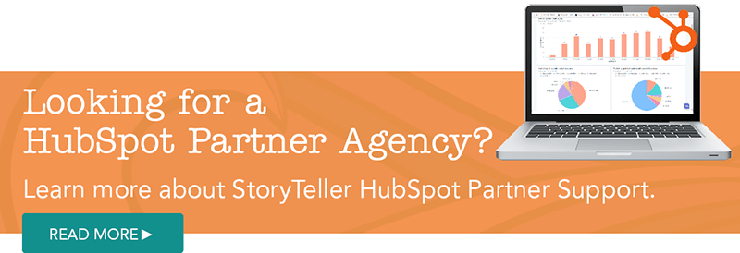3 Key Tools for an Effective HubSpot Lead Management System
Successful lead management requires a clean database with actionable information that fits into your overall sales and marketing blueprint. That’s...
7 min read
![]() StoryTeller Team
:
Aug 9, 2022 8:30:00 AM
StoryTeller Team
:
Aug 9, 2022 8:30:00 AM

Marketers (and humans) are always looking for the silver bullet solution that solves all of their problems. Weight loss, vacuum cleaners, or software… we all want a 5-second fix to our problems. Here at StoryTeller, we are firm believers in the power of HubSpot and the inbound marketing process. We have seen it work time and time again for companies. In 2021, HubSpot analyzed data from their over 103K customers to determine the ROI of the HubSpot platform, and found that within one year, the average customer sees an average 181% increase in web traffic and 159% increase in inbound leads — pretty compelling stats!
And while Hubspot is an amazing tool, with amazing successes, that doesn’t mean that you just get to pay the bill and you will automatically start seeing the leads roll in. We’ve seen lots of companies that struggle to get the machine working in their favor, and a lot of them make similar mistakes that cost them time, money, and leads.
So, here are 14 things to avoid when implementing HubSpot for your business:
Your customers are the lifeblood of your company – without them, you don’t exist. At the core of the inbound marketing methodology is creating content (blogs, white papers, webinars) that appeal to your target personas. This goes beyond just demographics — it’s about digging in, and interviewing real people. Hearing about real problems and pain points and then identifying what motivates them to make buying decisions.
Once you’ve spent some time researching and talking to your customers, then you can start to have some discussions about how to create fictional personas that help you represent these people as you are creating marketing materials. This seems like a really superfluous task, especially to well-established companies who have been communicating to their audience for a long time. But remember, your audience evolves, technology changes, the buying process changes and it’s important that you take those things into consideration.

Inbound marketing is about so much more than putting contact forms all over your website. In the world of the internet, many consumers check out tons of websites, resources, blogs, and documents before they ever make a purchasing decision. Are you contributing to that content?
Using relevant content, you can help your visitors make informed purchasing decisions that will lead to a trusted relationship between you and the consumer. As part of your customer research, find out what their average buying timeline looks like. What are their barriers? What questions do they still have? What hesitations? Help your visitors get the answers they need, and you will help them get one step closer to making a purchase.
It’s called marketing automation. One of the best things that you can do is figure out ways to automate relevant communication that connects your visitors and customers to content and products they might be interested in seeing. Whether it’s a regular recap of your best blog posts, an annual birthday email, or content based on the prospect’s website actions, HubSpot makes it easy to connect with your customers consistently.
Read more: 5 Simple Tips to Improve Your Email Workflow
Bad things happen when sales and marketing are on two different planets. It’s really important to get buy-in from your sales team. Creating a delightful experience starts from the second a prospect finds your content and goes all the way through until a sale is closed. It’s important for your sales team to understand, not only, how the inbound marketing process works, but how it will bring more leads, better leads, and hopefully, minimize the time to buy.
Work together with your sales team to create a process and flow of communication that works for both of you. As a marketer, you rely on your sales team to bring the deal to a close. Invite your sales team to the initial kick-off workshop, schedule regular meetings to update them on the latest and best-performing content. Go out to lunch and ask them what their sales barriers are, and help them create content that breaks down those barriers. Work as a team!
Want to help your sales team optimize their time? Lead scoring is the way.
With advanced lead scoring, you can use visitor data like pages viewed, videos watched, and forms submitted to create a hierarchy of leads for your sales team to use to prioritize their time. Lead scoring allows you to create a system where salespeople can find their most engaged, sales-qualified leads with just a few clicks.
Got a bunch of low-scoring marketing-qualified leads? Send them in a lead nurturing campaign and try to identify which of these leads are better suited for your company! This helps save your sales team time and they will love you for it!
One of the greatest advantages of marketing analytics in the technology-driven world is being able to identify which efforts are the most successful in driving, not only visitors, but most importantly, customers. Opting out of closed loop metrics creates an incomplete picture of your marketing efforts. Let’s say you get the most leads from referral traffic, so you invest all of your efforts into creating tons of referrals and then you find out that your close rate is WAY higher from organic traffic. These metrics are really important for investing your marketing dollars where they will make the biggest impact.
I’m just going to say this straight. DO NOT IMPORT PURCHASED LISTS.
Look, I understand, your leads have been down the last few months and you feel like you just need a quick shot of leads and then someone calls you and tells you that for just $5000 they can give you an AMAZING list of people who are ready to buy your product today. It’s enticing, but remember that conversation we had about silver bullets earlier. There are none. In fact, there are a lot more negatives to importing a purchased list. Things that kind of sound like bad B-Rated Movies that no one wants to watch:
… You get the idea.
But seriously, Hubspot has it right in their Terms & Conditions — if you send too much SPAM, your account will get suspended.
Your email database is a living, breathing thing. Sometimes it will grow like crazy and sometimes you need to prune the dead leaves and that’s okay. In fact, it’s probably for the greater good.
Here is the deal, more contacts cost more money. You want to be sure that you have the best, most qualified prospects in your database. It does your company no good to continue sending weekly emails to jaredallen@thevikings.com, because no matter how much you might wish for it… he is not coming back.
People are Googling things every single day. It’s the first step we take when researching, buying, and even asking dumb questions we are too embarrassed to ask a real person. HubSpot is a great tool for identifying keyword opportunities that have lots of interest, but not a lot of competition. These keywords are the sweet spot for creating content that attracts new visitors, new buyers to your website. By creating content that aligns with those keywords you can increase your website traffic exponentially.
If people like what you say, they will want to hear from you! When you provide real, relevant, helpful content, people don’t want to miss out on that. Don’t make them work to get notifications about your blogs and new content! Put it on your blog sidebar, your website homepage, include it as a form field, or test a pop-up box. Just don’t make it difficult. You just might feel like Oprah: “You get a blog notification! Everybody gets a blog notification!"
Pay-Per-Click advertising can be a really good option for companies with really competitive markets, but that doesn’t mean you should just link to your homepage and be done with it. By creating targeted landing pages based on the search terms, you can create integrated campaigns that engage readers, identify their unique problems and present a solution in the form of content or specific offer.
Connecting your PPC campaigns with HubSpot pages also allows you to see which of your paid keywords are creating the most conversions so that you can focus your efforts, and money, on those keywords.
HubSpot recently added Google Ads to list of tools that directly integrate with their Ads Reporting Tool, so it's not really easy to track the ROI of your advertising dollars on multiple platforms!
When HubSpot first launched, it was a simpler tool that was really focused on blogging and landing pages, and the email tool was NOT pretty. When we went through our onboarding, it was basically a two-hour webinar with our account person, and that was all you really needed to know.
The world of a SaaS company like HubSpot changes quickly. Even a year or two of technological development and best practices evolution makes a WORLD of difference. A lot of companies fall into the trap of thinking that the tool is easy enough just to teach yourself. However, there are a lot of facets and best practices that you will miss out on and stumble through if you are trying to do it on your own. Get the help of a HubSpot specialist or an inbound marketing agency who has been through the ropes with the tool. At the very, very least, check out HubSpot Academy, which has free trainings for many facets of its software. Don’t waste precious time and money fumbling through the software.
With a world of possibilities, it can be really easy to get distracted by the endless opportunity and different shiny objects that you can try. It’s important to have a firm strategy that is executable. The strategy should be focused on your biggest gaps and lowest hanging fruit. These are the places where you will notice the biggest change in performance from what you are doing right now.
If you have already implemented HubSpot and you feel like you have just been chasing your tail, don’t hesitate to reach out and schedule a workshop. These are great one-day events that help companies get focused and identify what tasks can be done that will help with your company’s business objectives.
Most companies set goals. “We want to be getting 500 leads per month”, or worse, “We just want more leads”. It’s important to know where you want to be heading, but SMART goals take it one step further.
By setting goals that meet these requirements, you challenge your company to think critically about what steps are necessary to get to where you want to go. If you want to get 500 leads per month, but you are getting 12 new leads per month right now, it’s important to set not only a specific goal, but an achievable one. If you want to get there by next month, it’s going to take a LOT of elbow grease in a short period of time.
So it might be better to set an incremental goal and then work on the pieces to build that kind of pipeline.
What’s at the heart of the inbound methodology is the idea of connecting to your audience in a real, relevant, honest way that helps them solve a problem. The HubSpot tool isn’t a 5-minute fix that’s going to transform your marketing overnight. It is a long-term investment in creating a sustainable pipeline and after nearly two decades, we're still drinking the Kool-Aid.
(Editor's Note: This blog was published in 2016, and was updated in 2022.)


Successful lead management requires a clean database with actionable information that fits into your overall sales and marketing blueprint. That’s...

People have been talking about the power of digital marketing for years. I've come to realize, though, that most of that talk is all about aligning...

If you haven't heard the news, HubSpot is sunsetting their keywords tool. The company has spent the better part of the last 10 years preaching the...